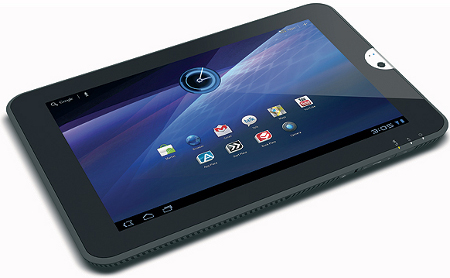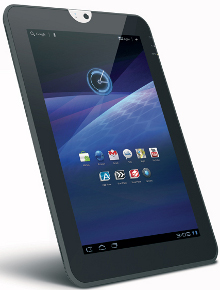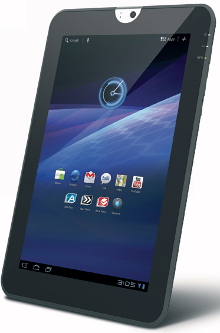Toshiba Thrive tablet offers Android 3.1, full-sized ports
Jul 11, 2011 — by Eric Brown — from the LinuxDevices Archive — 3 viewsToshiba began selling its long-awaited 10.1-inch tablet in 8GB ($430), 16GB ($480) and 32GB ($580) Wi-Fi only versions. The Android 3.1-powered Toshiba Thrive is thick and heavy, but its Tegra 2 processor, 1280 x 800 display, and full-size HDMI, USB 2.0, and SD connections go a long way toward compensating, says one review.
Toshiba first tipped its Toshiba Tablet in January, and the same design reappeared in the Regza AT300 version that was recently introduced in Japan. In early June, Toshiba confirmed rumors of its Toshiba Thrive, and said it would start selling the device in the U.S. on July 10.
The Thrive indeed appears to be shipping now at Toshiba Direct, Amazon, Best Buy, Newegg, Office Depot, and other retailers in Wi-Fi only versions for 8GB ($430), 16GB ($480), and 32GB ($580) flash memory. This at least offers pricing flexibility, if not an actual bargain. (Then again, bargains are hard to find in the Honeycomb field.)

Toshiba Thrive
(Click to enlarge)
Like most Honeycomb tablets, the Thrive offers a full array of Google services and apps, as well as other Toshiba and third party apps. (A full list can be found in the Thrive page linked to at the end of this story.)
The tablet ships with 1GB of DDR2 RAM, as well 8GB, 16GB, or 32Gb of flash storage, Further memory expansion is possible via the devices' full-size SD slots, says Toshiba.


Toshiba Thrive in portrait mode
(Click on either to enlarge)
Wireless features include 802.11b/g/n, Bluetooth 3.0, and GPS, but there's no cellular connection, at least in this initial version. Toshiba's tablet offers a full-size HDMI port, as well as a standard USB 2.0 port, a mini-USB 2.0 port, and a headphone port, says the company. Stereo speakers, a microphone, and various sensors round out the features, which are detailed in the spec listed below.
The 1.6-pound tablet provides battery life of 11 hours in mixed usage, claims Toshiba. Customers can choose from six color choices for the "easy-grip" back cover, says the company.
Accessories include a $40 power docking station with an additional audio-out connection, as well as a multimedia docking station. The latter "Multi Dock" costs $60 and includes features such as an additional HDMI port, two more USB 2.0 ports, and another audio port, says Toshiba.
Features and specifications for the Toshiba Thrive include:
- Processor — Nvidia Tegra 2 (dual-core, 1GHz)
- Memory — 1GB DDR2 RAM; 8GB, 16GB, or 32GB flash
- Flash expansion — SD card reader
- Display — 10.1-inch, 1280 x 800 capacitive touchscreen; 16:10 aspect ratio; backlit
- Cameras — 5-megapixel autofocus, with 720p video capture; 2-megapixel front-facing webcam
- Wireless:
- 802.11b/g/n
- Bluetooth 3.0 + HS
- GPS
- I/O:
- HDMI port
- mini-USB 2.0 port
- USB 2.0 port
- docking port for optional power dock or home-entertainment multi dock
- Audio:
- stereo speakers
- microphone
- 3.5mm headphone jack
- SRS Premium Voice Suite; Toshiba Sound Enhancements
- Other features:
- ambient light sensor, gyroscope, accelerometer
- volume control, screen rotation lock
- 6 x color choices for easy-grip back cover
- Power — 30 W auto-sensing, 100-240V/50-60Hz input
- Battery — user-removable Li-Ion (23Wh) for up to 11 hours of use
- Weight — "starting at" 1.6 lbs
A tablet for MacGyver types, says review
No dimensions are listed for the Thrive, but one early review from MobileTechReview notes that its main flaw is its 0.62-inch thickness. That is compensated, however, by the array of full-size ports, including the full HDMI, USB 2.0, and SD-card connections, notes the review by Lisa Gade.
The Thrive's removable, 2030mAh battery didn't make it to the claimed 11 hours, writes Gade, but did last 7.1 hours with Wi-Fi and mixed tasks including 45 minutes of YouTube video.
Not only is the Thrive the thickest Honeycomb tablet on the market, says the review, but it weighs in at a hefty 1.68 pounds rather than the listed 1.6 pounds. This is not much heavier than the Motorola Xoom, but it's a a load compared to the 1.25-pound Samsung Galaxy Tab 10.1, says the review.

The Thrive stands out with its full-size ports
(Click to enlarge)
The standard SD slot, combined with Toshiba's system enhancements and file manager, "mean you can view images on your digital camera's SD card or store files on a card, and you can use flash drives and hard drives with the tablet, so you need not try and cram your life into the tablet's internal storage," writes Gade. This is why Toshiba made the unusual move of offering an 8GB model, she suggests.
Gade also praises the device for its display, design, processor, and other features, all of which add up to a positive review. In the end, she concludes: "The Toshiba Thrive is the tablet for MacGyver types who want maximal versatility and expandability in a rugged package."
Availability
The Toshiba Thrive is available now at Toshiba Direct's Thrive site, as well as other retail locations including Amazon, Best Buy, Newegg, and Office Depot. Pricing is as follows, based on supplied flash memory: 8GB ($430), 16GB ($480), and 32GB ($580).
This article was originally published on LinuxDevices.com and has been donated to the open source community by QuinStreet Inc. Please visit LinuxToday.com for up-to-date news and articles about Linux and open source.